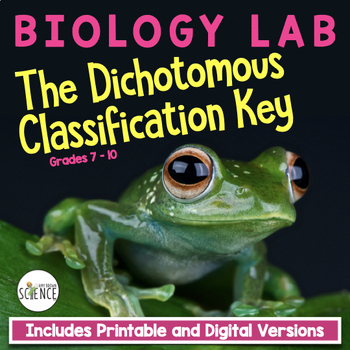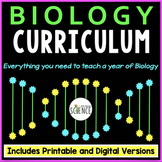Classification Lab on Dichotomous Keys - Classification of Living Things
- Zip
- Google Apps™

What educators are saying
Also included in
- This complete teaching unit on classification and taxonomy includes everything you need to teach this unit to your life science or biology students. Many of the resources are available in BOTH printable and digital formats. Resources include a 71-slide PowerPoint presentation packed with colorfulPrice $35.19Original Price $58.71Save $23.52
- This NO PREP, PRINTABLE, EDITABLE, AND DIGITAL Biology Curriculum contains everything you need for an entire year of Biology! For less than $3 a day, you can save your time, energy, and sanity. Each of the 20 Complete Units includes a teaching PowerPoint presentation, notes, labs, homework assignmenPrice $420.00Original Price $988.18Save $568.18
Description
In this dichotomous key classification lab activity, students will rotate through stations using 3 different dichotomous keys in order to classify 27 different invertebrates and vertebrates. As students become masters of classification keys, they will have fun exploring the classification of living things. All pictures and diagrams needed for the activity are included.
Both printable and digital versions of this resource are included. The student handouts can be printed or used in the paperless digital format in your Google Drive, Google Classroom, Microsoft OneDrive, or similar. This resource is perfect for traditional classroom settings, 1:1 schools, or for distance learning.
What is included in this resource?
- Printable and Editable Student Lab Handouts
- Digital paperless versions (not editable) for use in Google Drive, Google Classroom, and/or Microsoft OneDrive
- 27 Full-color, high-quality photographs of animals that will be classified using the dichotomous keys
- Teacher Guide and Answer Key
Suitable for Biology or Life Science Students in Grades 7 -12.
What is the Purpose of this Activity?
- To teach students how to use a dichotomous classification key.
- To review and reinforce the basic structural characteristics used in classification.
- To encourage good observation skills, problem solving and critical thinking.
Students will move and rotate through various stations set up in the lab or classroom. Each station will have a picture of an animal in the animal kingdom. The students will have a few minutes to look at the picture, observe the characteristics of the animal and determine its classification within the animal kingdom.
Students will choose between three simple classification keys: Dichotomous Key to the Classes of the subphylum Vertebrata, Dichotomous Key to the Phyla of Invertebrates, or Dichotomous Key to Selected Classes of the Phylum Arthropoda. Students will use the appropriate classification key and record their answers in a data table.
This activity is appropriate for middle school grades as well as high school general science and biology classes. This is one of my favorite labs that I do with my Biology I students. They love looking at the pictures of all the different animals and learning how to classify them.
Answers and Teacher Preparation Notes are included.
Related Products Include:
Classification and Taxonomy Complete Unit Plan Bundle
Classification and Taxonomy Task Cards
Dichotomous Classification Key to Thanksgiving Dinner
Insect Dichotomous Key Activity
Kingdoms of Life Mix and Match Card Game
Classification PowerPoint and Notes Set
Classification Using a Dichotomous Key
Dichotomous Classification Key to a "Crazy" Animal Kingdom
Dichotomous Key to the Genus "Smiley"
Classification and Taxonomy Jeopardy Review Game
Evolution and Classification: Warm Ups, Bell Ringers and Interactive Notebooks
Learning to Use and Construct a Dichotomous Classification Key
Classification Crossword Puzzle
Classification (Taxonomy) Homework or Study guide
Classification and Diversity of Life Unit Test
Activity: Let's Build a Cladogram!
Classification and Taxonomy Quiz
Earth's History and the Origin of Life on Earth PowerPoint with Notes for Student and Teacher
Free Dichotomous Classification Key to Holiday Giving and Community Service
For updates about sales and new products, please follow my store:







